
Bird Trail of Iveragh
A little bit about the trail
No matter the time of year, you’ll find some beautiful, feathered friends to accompany you on your Iveragh adventures. Mid-September sees the beginning of the influx of Winter waders and other migratory birds. Many of these birds have spent the summer months in northern countries such as Greenland but move south to the milder conditions on Iveragh when those countries freeze over. Species such as Redwing (Deargán sneachta) and Fieldfare (Sacán) feast on the bounty of seasonal berries such as rowan and ivy while our wetlands are a hive of activity with wading birds chasing the tides.
Spring sees the departure of many over our overwintering birds, but a new cast of characters are already on the wing. Mostly coming from southern regions, our skies come alive with the aerial acrobatics of Swallows (Fáinleog), Swifts (Gabhlán gaoithe) and Martins (Gabhlán) and a cacophony of calls rises from seabirds nesting on the cliffs of Iveragh. These spring arrivals will raise their young here over summer, feeding on a buffet ranging from tiny insects to fish, so keep your eyes peeled whether you are on land or at sea.
It's crucial that we do not disturb our wildlife – including our birds. Many species lead a finely balanced life of finding enough food to survive, evading predators, and conserving energy levels by resting. Please keep your distance, ensure dogs are on leads, and be especially vigilant during the nesting seasons of spring and summer.
For more information on how to identify birds, check out our Birdwatching Tips.
HOW TO EXPERIENCE THE MAP:
To view the map locations on your mobile device, click on the square icon in the top right hand corner of the map to open the map in a web browser or Google maps app. To view the map in this page, click on the square in the top left of the map.
TRAIL GUIDE:
Below the map is the guide for the map and the selected points. There is also an alternative Storymap:
Bird Trail of Iveragh
-
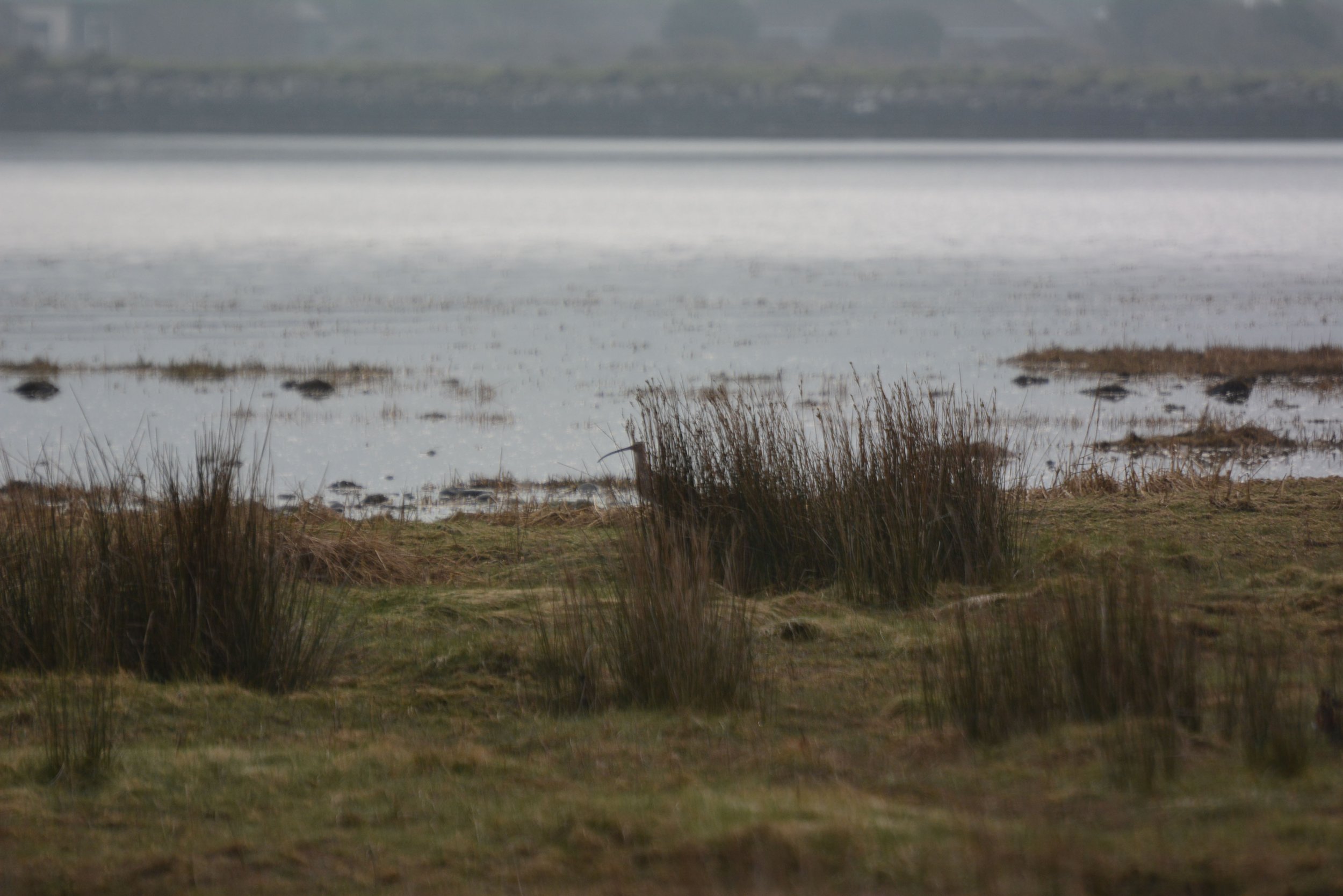
1. Cromane Harbour
The long, thin sandbar at Cromane offers the opportunity to search for birds such as dunlin and divers on the seaward side, while the salt marsh on the other side provides a real game of bird hide and seek. September brings large numbers of winter migrants from cooler countries further north. The mild, ice-free Iveragh winters are perfect for wading birds such as Curlew (Crotach), Light-bellied Brent Geese (Cadhan), and many more.
Watch and listen for Teal (Praslacha) – one of our smallest ducks – practice their mating rituals in early spring when gathering in the pools of the salt marsh. The males, adorned with smart teal and chestnut eye stripes, emit whistling calls while dipping their heads before dramatically raising their breast and arched neck up and out of the water.
Cromane is also the place to keep an eye out for a more unusual visitor. A Spoonbill (Leitheadach) has been spotted each winter in Cromane for around 15 years. These tall, elegant, white birds have a specially adapted bill which they use to filter food from the water in a side-to-side swishing movement. Kerry Birding is a great site to keep an eye on reports of any unique arrivals seen by the network of birdwatchers in the region. For a hot drink or tasty snack, keep an eye on seasonal opening hours for The Boathouse.
-

2. Rossbeigh Strand
The sheltered wetlands behind/east of the sand dunes is a great bird watching site for winter waders. The bubbling calls of Curlew (Crotach) float on the breeze from the reeds while the gentle honking of Light-bellied Brent Geese (Cadhan) flying overhead will stop you in your tracks. The large and colourful Shelduck (Seil-lacha) can be seen here along with Wigeon (Rualacha - look for the cream ‘mohawk’ head stripe on the males) and the tiny Teal (Praslacha). Smaller waders swarm the tidal flats when the water has retreated and exposed the invertebrate buffet in the sand. Sanderlings (Luathrán), Dunlin (Breacóg) and Ringed Plover (Feadóg chladaigh) mix together in large numbers, their tiny legs a blur as they search feverishly for food before the tide returns.
Red-billed Choughs (Cág cosdearg - Ireland’s rarest corvid) and Common Ravens (Fiach dubh - Ireland’s largest corvid) can be seen and heard above the sand dunes. Listen for the pitchy ‘keee-awwww’ of the chough and the deep ‘cark cark’ of the raven as they glide overhead. In early spring, Rossbeigh is alive with the calls and displays of Meadow Pipits (Riabhóg Mhóna) and Skylarks (Fuiseog). The pipits fly higher and higher before holding their wings wide and parachuting back to earth while skylarks appear to be able to sing endlessly from the skies above.
There is a strong temptation to venture out onto the mudflats to get a closer view of the birds but it is always important to remember not to disturb our feathered friends. Any time that they spent avoiding dogs or humans can take from the time they have available to feed or can use up the energy that they are trying to conserve by resting.
If you feel like stretching your legs, have a look at the Rossbeigh Walks.
-

3. Ferta Estuary
There are several points around the Ferta Estuary from which to gain excellent views of the birds which call this part of Iveragh their home. One spot is the Cahersiveen Town Park next to the Old Barracks. Relax on a bench, sit back, and switch on your senses. Listen for Redshank (Cosdeargán), Eurasian Oystercatcher (Roilleach) and Curlew (Crotach) along the river or perhaps hear your first Chiffchaff (Tiuf-teaf) or Willow Warbler (Ceolaire sailí) of the year from the hedgerow lined banks over the water.
Close to the estuary is Carhan Woods (turn left at the Garda Station on the Fair Green and follow the signs for Beentee Loop). This stand of native woodland is a rare gem on Iveragh. Oak, hazel, holly and more play host to a web of connectivity between our plants and animals. The wood is an ideal spot to tune in to the annual dawn chorus. Rising in volume from late February, the feathered residents of Iveragh will sing and call to lay claim to the best territory for breeding. Starting before the sun has ventured above the horizon, looking for the singer is a fun way to put the voice with the bird. Practice with these short videos by Welsh naturalist, Ben Porter.
For more information visit the Cahersiveen webpage. You might also consider taking a kayaking or SUP tour from Cahersiveen marina.
-

4. Doulus Head
It takes just over an hour to get from the car park to the tip of Doulus, but as with all walks on Iveragh, it is worth it. One bird species you are sure to encounter on your walk is the Red-billed Chough (Cág cosdearg). These birds breed along the cliffs during the summer and stay to forage on hillocks in the sheep-grazed pastures over winter.
-
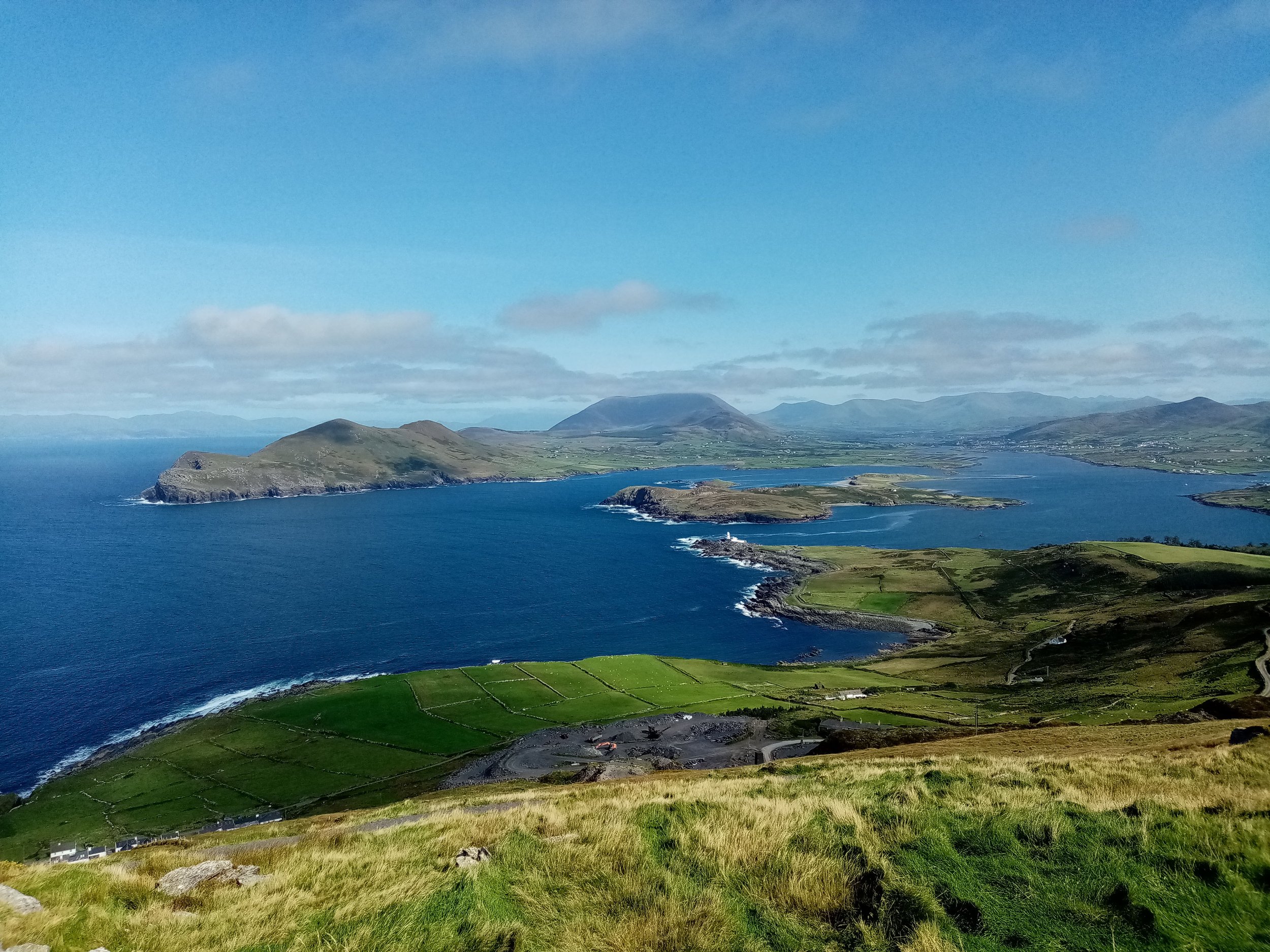
5. Geokaun Mountain and Fogher Cliffs
The mountain and cliffs with up to 240m height are a fantastic place to watch the aerial acrobatics of Red-billed Choughs (Cág cosdearg) and Common Ravens (Fiach dubh). Occasionally you will find a Kestrel (Pocaire gaoithe) swooping by, causing smaller birds such as Meadow Pipits (Riabhóg Mhóna) to disapear. And if you are lucky, you will also get to spot some dolphins foraging in Dingle Bay.
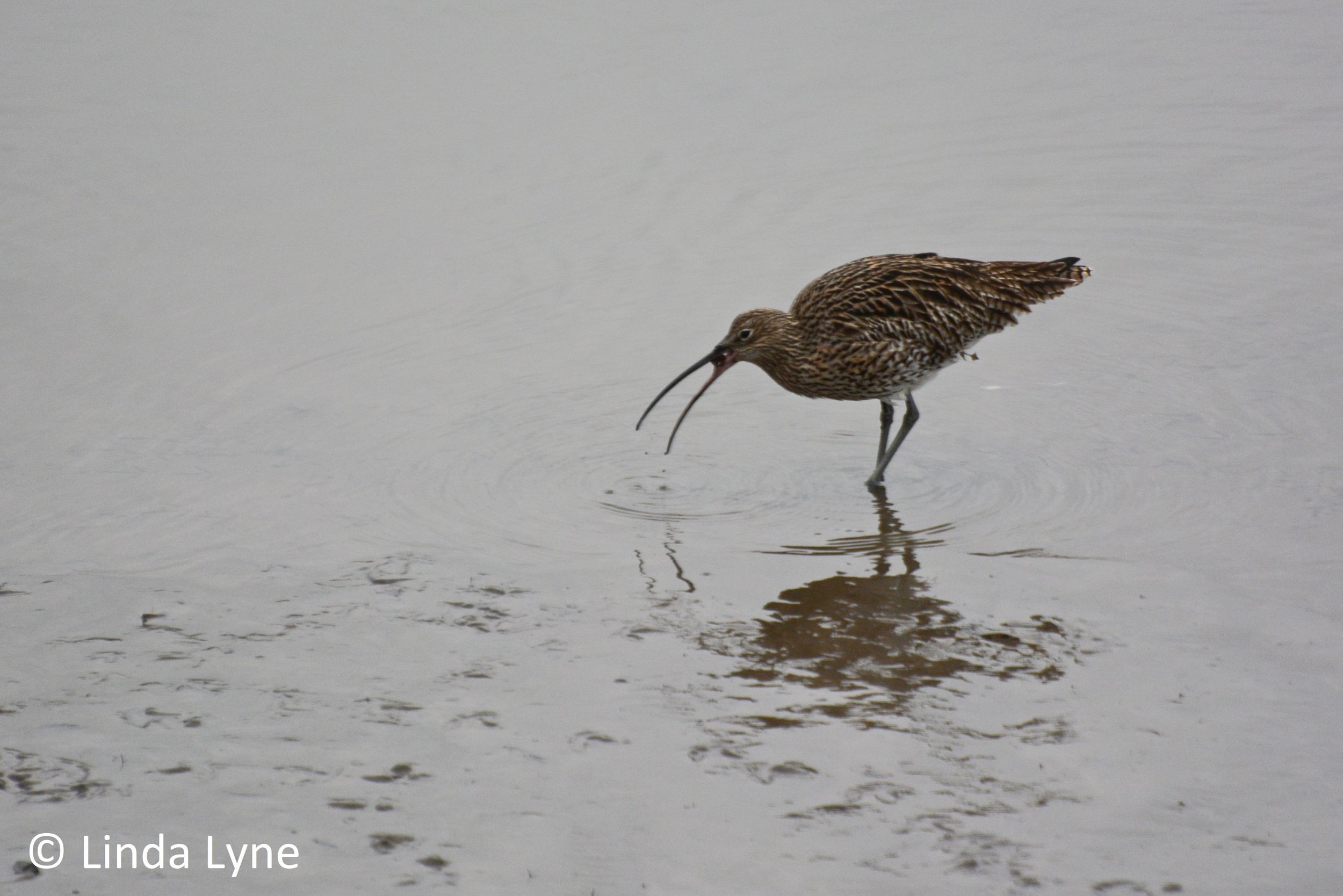
6. Bray Head
Topped by a Napoleonic tower, which was also used as lookout during both World Wars, you can reach the top of Bray Head after a 20-minute walk up the gravel path. On your way you will come across, Meadow Pipits (Riabhóg Mhóna), Skylarks (Fuiseog), Kestrels (Pocaire gaoithe) and Red-Billed Choughs (Cág cosdearg). Black-legged Kittiwakes (Saidhbhéar) and Northern fulmars (Fulmaire) visit the cliffs to breed during the summer. Those same cliffs are also used by Common Ravens (Fiach dubh), which can be seen and heard along the edges. Be mindful- there are no barriers to prevent you from falling. One seabird you can find along the whole west coast of Iveragh all year round, is the Northern Gannet (Gainéad). This almost completely white bird is the largest seabird in the North Atlantic and easy to spot when circling the sky. You are in for a real treat when a shoal of fish passes by underneath them and they start plunge diving, shooting into the water like arrows.
7. Portmagee Channel
The retreating tide in the channel unveils a buffet for birds. September to March is especially good for bird spotting as this is when our overwintering wading birds have arrived from their northern breeding grounds in Greenland, Iceland and beyond. Look for Greenshank (Laidhrín glas) in ones and twos or their more sociable cousins, the Redshank (Cosdeargán), in larger numbers. ‘Shank’ is an old term for a leg so the clue in their names will help you tell them apart.
While you may be tempted to keep your eyes on the mudflats, don’t forget to look up! On one visit to the area, a large mixed flock of gulls took to the air. Scanning the sky above them revealed the culprit – a Peregrine (Fabhcún Gorm)! The many eyes on the ground had spotted this arial predator on the prowl. We watched as the peregrine glided above the tideline before turning inland over Pound and headed towards Coomanaspig.
While seals and dolphins often frequent the Portmagee Channel, it is also worth looking for seabirds that have ventured closer to shore. The Black Guillemot (Foracha dhubh - mostly white in winter) can sometimes be seen diving for food while witnessing the dramatic diving prowess of our Northern Gannets (Gainéad) is an experience straight out of a TV nature documentary.
Explore the Knockeenawaddra and Pound Loops to search for birds and other wildlife.
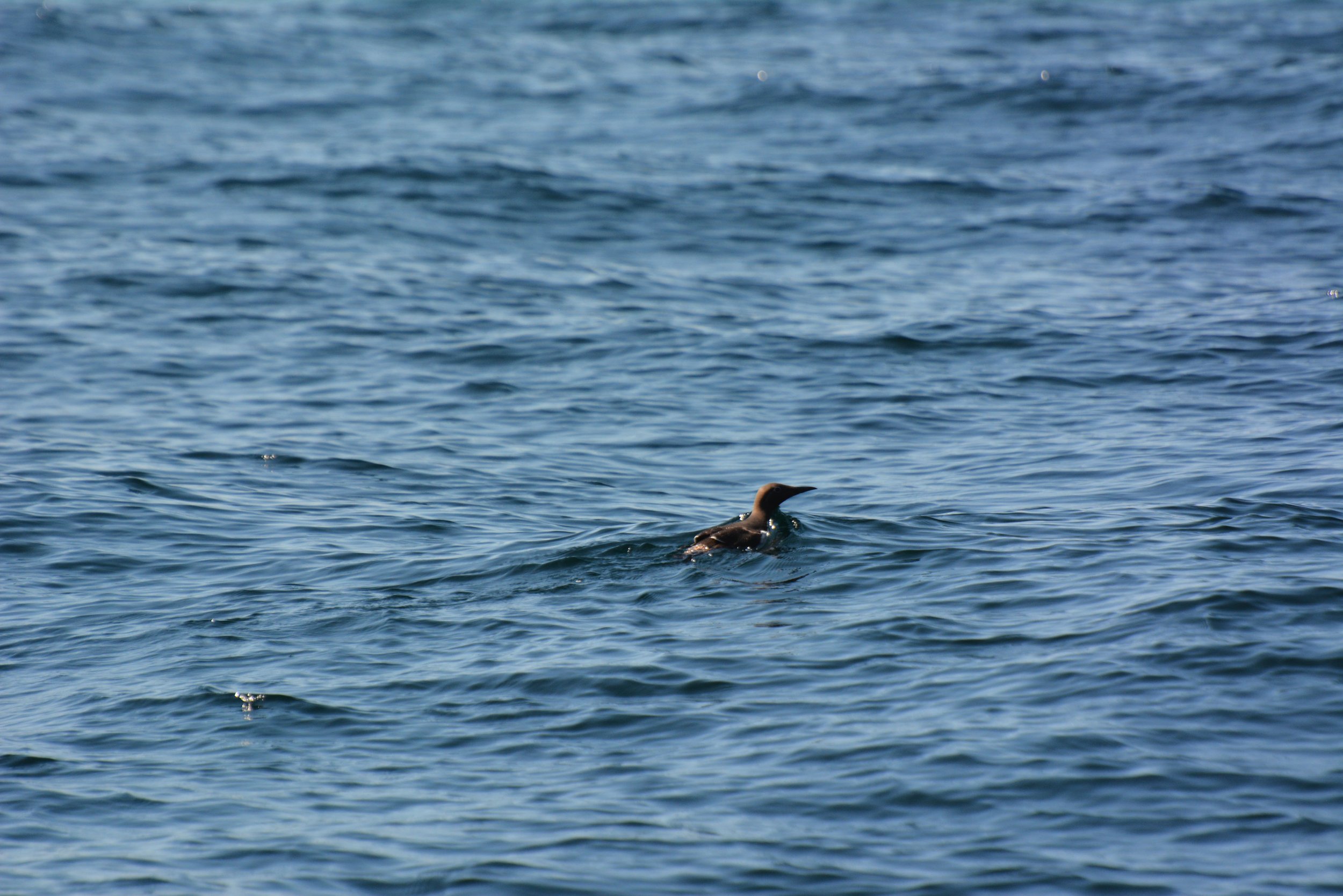
-
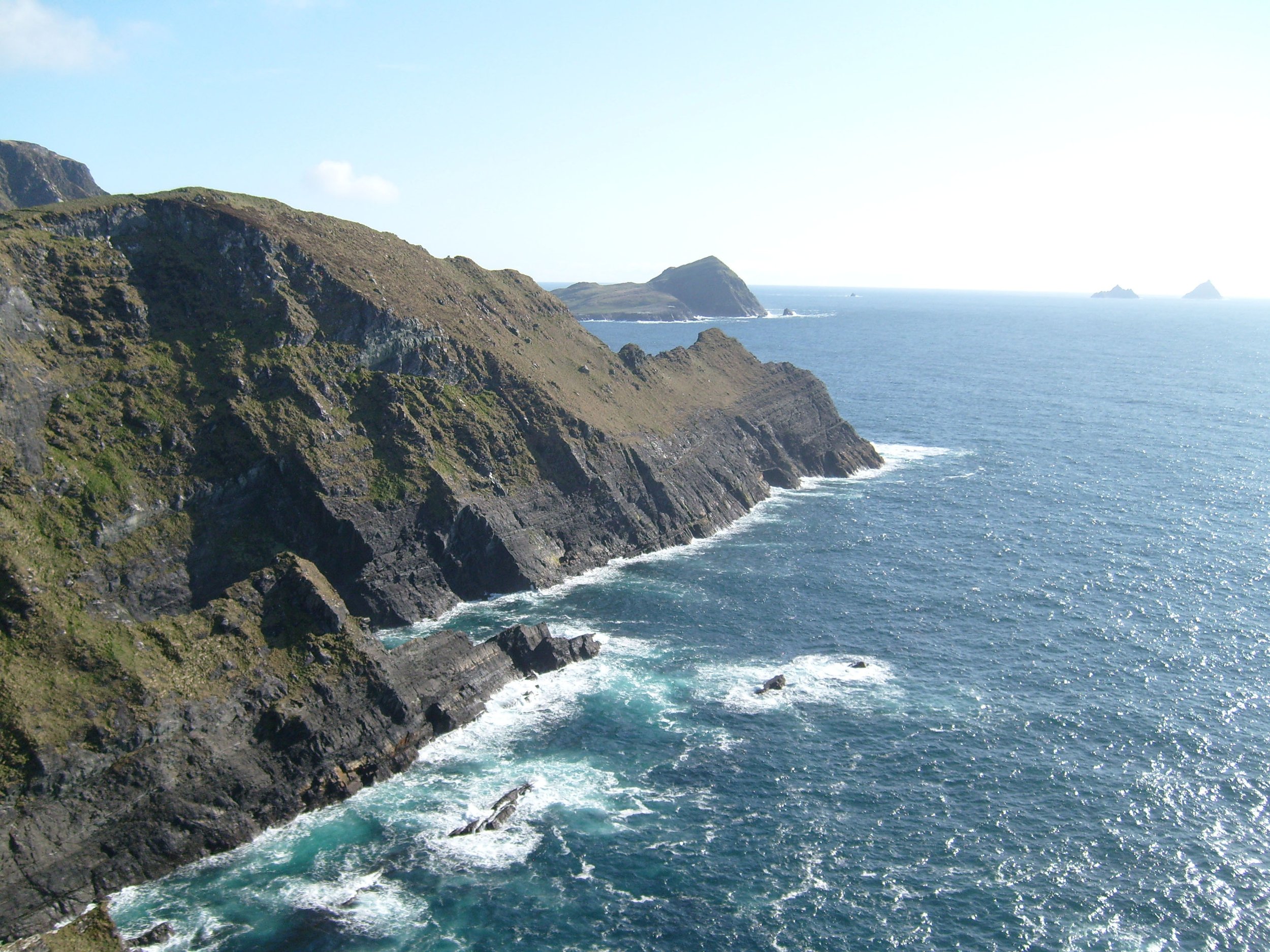
8. Kerry Cliffs
Puffin Island is an uninhabited island and reserve just off the cliffs, which holds thousands of Atlantic Puffins (Puifín), but also high numbers of Manx Shearwaters (Cánóg dhubh) and Storm Petrels (Guairdeall) over the summer months. Being so close to the island, you should definitely keep an eye open for its namesake. These small black and white birds with their orange beak and feet (only during breeding season) can be seen flying around the island. Because their wings are fairly short, they need to constantly flap to stay in the air. Look for them sitting on the water surface and going for dives, if fish are around. Under the water, their short wings make them powerful and agile hunters.
Other birds you can see breeding on the cliffs are Northern fulmars (Fulmaire) and Red-billed Choughs (Cág cosdearg).
-

9. Skellig Islands
During the spring, plenty of seabirds, including the Atlantic Puffin (Puifín Atlantach) and Northern Gannet (Gainéad) return to their breeding colonies. While puffins rear their pufflings (yes, this is an actual word) inside their burrows on the larger island, parent birds can be seen regularly out in the open, catching fish and carrying them back in their beaks. Also look for Razorbills (Crosán), Northern Fulmars (Fulmaire) and Manx Shearwaters (Cánóg dhubh), who hide their chicks in burrows and crevasses of the old beehive huts. The largest seabird of the North Atlantic, the Northern Gannet, takes over the smaller of the islands, Little Skellig (Sceilg Bheag), making it the second largest gannet colony in the world. Stained by bird guano, its bright white colour makes it easily distinguishable from Skellig Michael (Sceilg Mhichíl).
-

10. Bolus and Ducalla Head
These headlands can be reached from either Ballinskelligs, or the Ducalla car park. Paths over boggy sheep pastures are signposted. On your walk you will likely encounter Common Ravens (Fiach dubh) and Red-billed Choughs (Cág cosdearg), foraging and flying around, but also Northern fulmars (Fulmaire) and Herring Gulls (Faoileán scadán), nesting along the cliffs. And if you are really lucky, you will be surprised by a Sparrowhawk (Spioróg) on a fence pole, watching your every move.
-
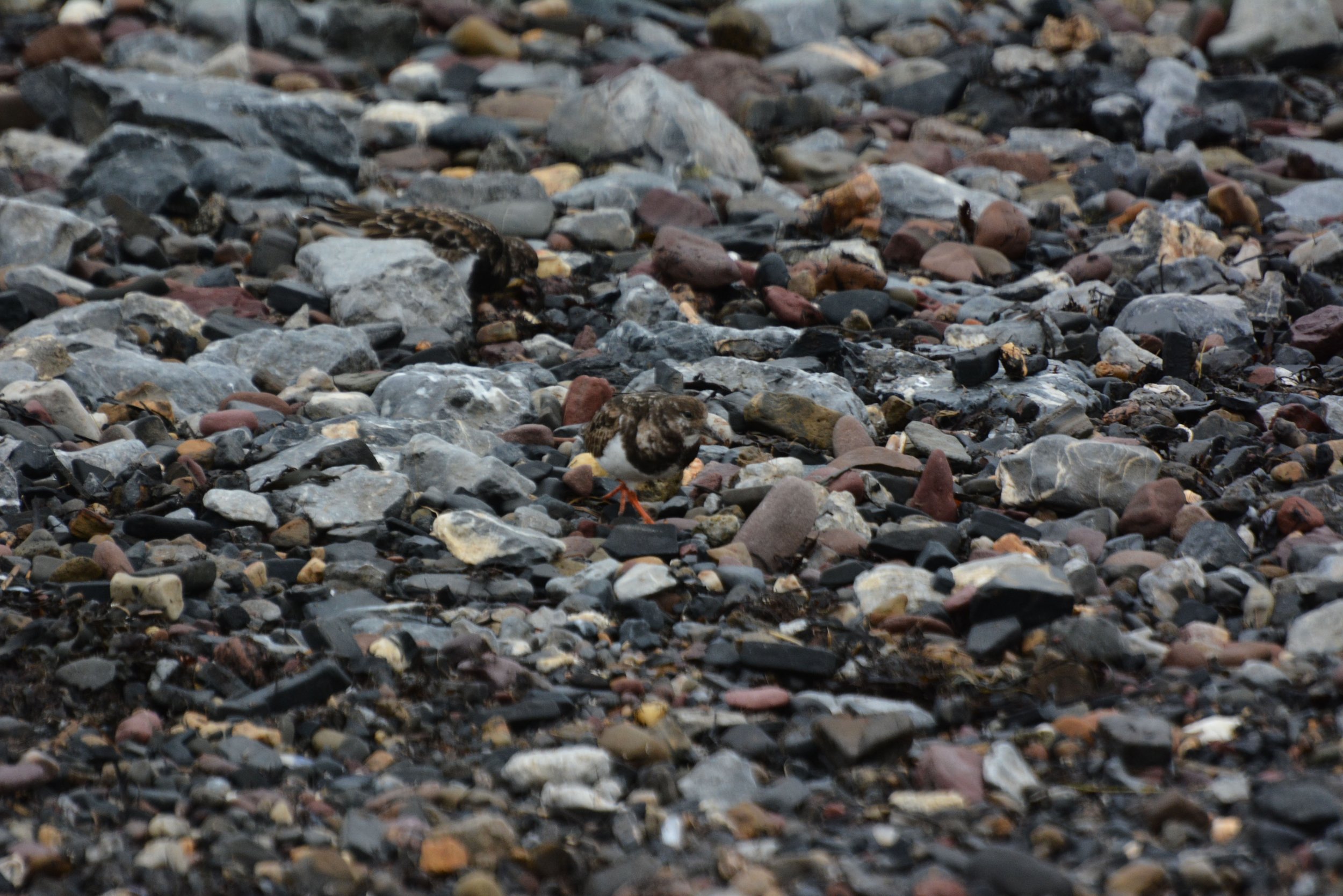
11. Ballingskelligs Beach
Close to shore, on the rocks and pier next to the castle, you may find Cormorants (Broigheall) and Shags (Seaga) drying off their feathers all year round. At the beach itself, foraging Ringed Plover (Feadóg chladaigh), Turnstones (Piardálaí trá), Sanderling (Luathrán) and Light-bellied Brent Geese (Cadhan) are a common sight during the winter months. Be mindful not to disturb them while strolling along the beach.
-

12. Reenroe Beach and Inny Estuary
Taking a right at the carpark, the cliffs off Reenroe offer a nice walk around the old hotel ruin. The slight elevation provides good chances to watch for wintering birds. While Common Scoters gather in flocks of 100s on the water in the bay, Light-bellied Brent Geese (Cadhan), Wigeon (Rualacha), Ringed Plovers (Feadóg chladaigh) and Curlew (Crotach) can be found along the shore over the cold winter months. Another species becoming more frequent on the peninsula, the Glossy Ibis (Íbis niamhrach), has also been spotted on grasslands near the cliffs and around the hotel.
The beach carries on for about another kilometre eastwards, before you reach the Inny estuary. Here is another fabulous spot to watch for wetland birds. A rare and very exciting sight has been an Osprey (Coirneach).
-

13. Waterville
Year-round inhabitants of the bay include Cormorants (Broigheall), Shags (Seaga), Eurasian Oystercatcher (Roilleach) and Northern Gannets (Gainéad), which you might even see without your binoculars. Some much smaller winter visitors that can be seen on the rocky shore are Turnstones (Piardálaí trá). Those little birds get their name from actually turning seaweed (rather than stones) on their search for their next meal.
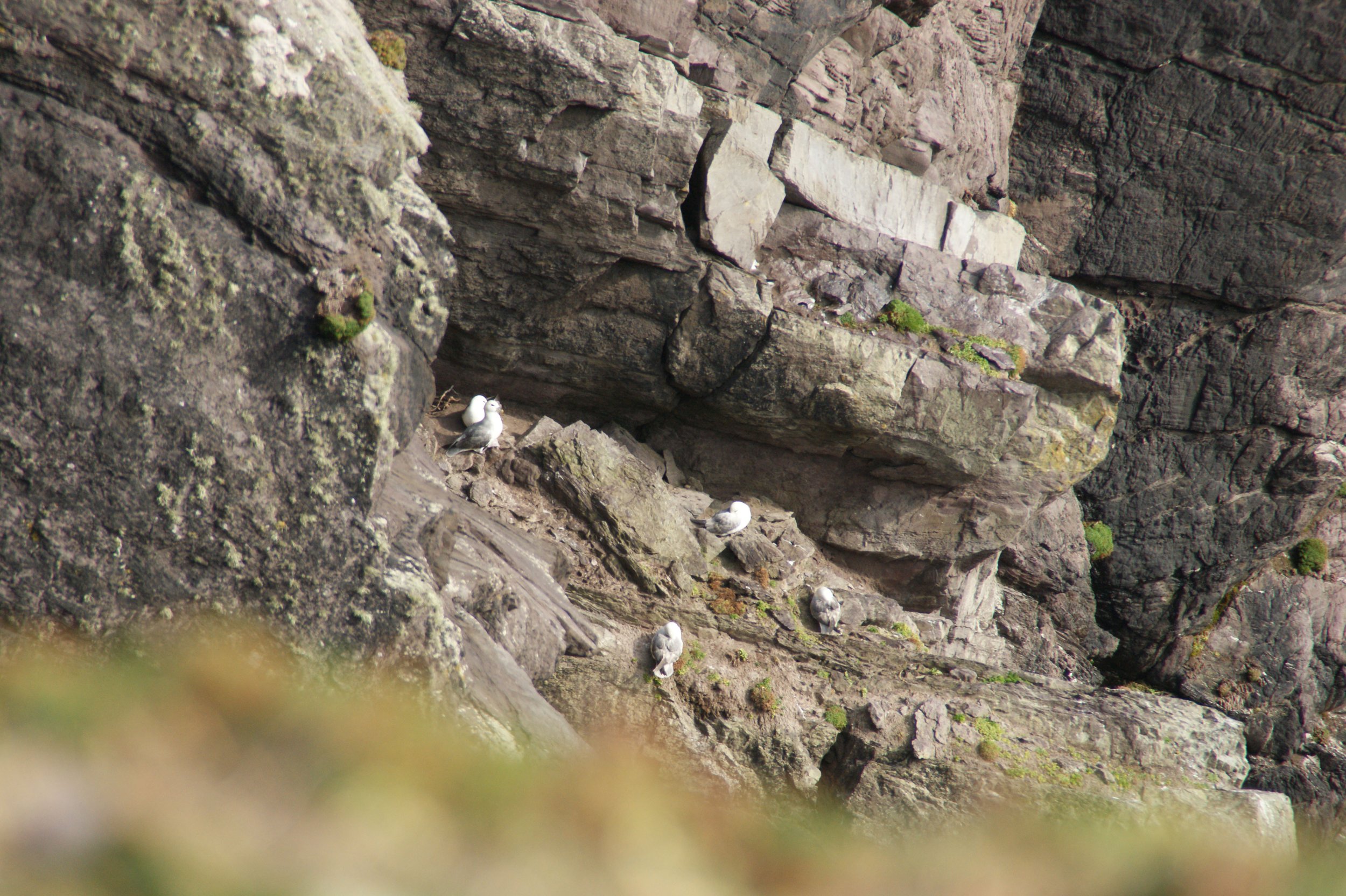
14. Hog’s Head
There are several spots from where to look into Ballinskelligs Bay or Kenmare Bay on this headland. You may spot Northern fulmars (Fulmaire), Manx Shearwaters (Cánóg dhubh), Storm Petrels (Guairdeall), Arctic Terns (Geabhróg artach) and Lesser Black-backed Gulls (Droimneach beag), all of whom breed on Deenish and Scariff islands on the edge of Derrynane Bay. A year-round resident, Red-billed Chough (Cág cosdearg), are frequently seen along the cliffs.
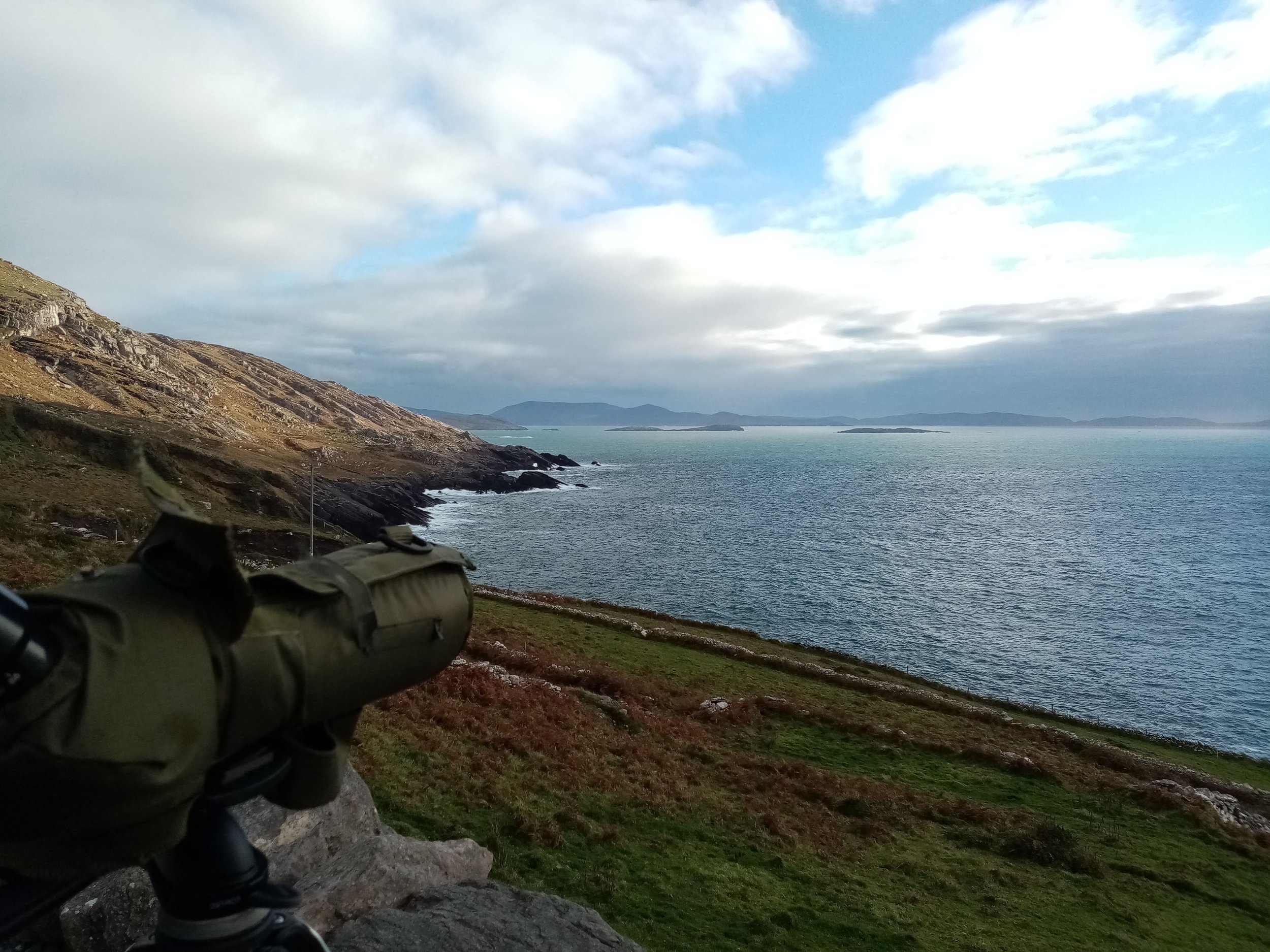
-

15. Bull and Cow Rock
Situated at the entrance to Kenmare Bay and 4km off the most southwesterly tip of the Beara peninsula, Bull Rock is the taller, and arguably the more impressive, of the two islands. Besides the lighthouse, which is still operational but has been unmanned since 1991, this 228m high rock holds another Northern Gannet (Gainéad) colony. In good weather conditions you can even catch a ride through the ‘Tunnel to the Underground’ with Skellig Tours or Skellig Coast Discovery.
The wider, neighboring island is the Cow Rock, which from a certain angle, looks like an elephant. Other seabirds nesting on these islands include Atlantic Puffins (Puifín), Storm Petrels (Guairdeall), Great Black-Backed Gulls (Droimneach mór), Black-legged Kittiwakes (Saidhbhéar), Common Guillemots (Foracha), Northern Fulmars (Fulmaire), Razorbills (Crosán) and Herring Gulls (Faoileán scadán).
-

16. Derrynane Beach
If you are lucky, you will hopefully see one of Ireland’s rarest members of the crow/corvid family – the Red-billed Chough (Cág cosdearg) – during a visit to Derrynane. In winter, they can sometimes be seen foraging through clumps of seaweed washed up on the beach after a storm. A vocal bird, their constant ‘keee-awww’ calls to each other will give away their presence and you will soon understand why a group of these birds is referred to as a ‘chattering of choughs’.
The lagoon behind the dunes plays host to a number of wetland birds from the crisp white of the Little Egret (Éigrit bheag) to the impossibly quick feet of the tiny Sanderling (Luathrán). Listen for the energetic singing of the Skylark (Fuiseog) in spring – they surely win the gold medal for the longest song – and the adjacent Derrynane woods is a must for songbird lovers, especially during the dawn chorus peak.
If you want to enjoy a longer walk, check out the Derrynane Loop.
-

17. Lamb’s Head
On your way to the lookout tower, watch out for lichen covered rocks where you might find a Kerry Slug (Drúchtín ballach). If you keep your ears open you might also hear the calls of Red-billed Choughs (Cág cosdearg) and Common Ravens (Fiach dubh), which can be seen foraging here frequently. From the tower, you will enjoy the view over Derrynane Bay and Kenmare Bay. Between spring and autumn, look for auk species such as the Black Guillemot (Foracha dhubh), Common Guillemot (Foracha) and Razorbill (Crosán) sitting on the water below. All of them breed in several colonies along the west coast of Iveragh.
-
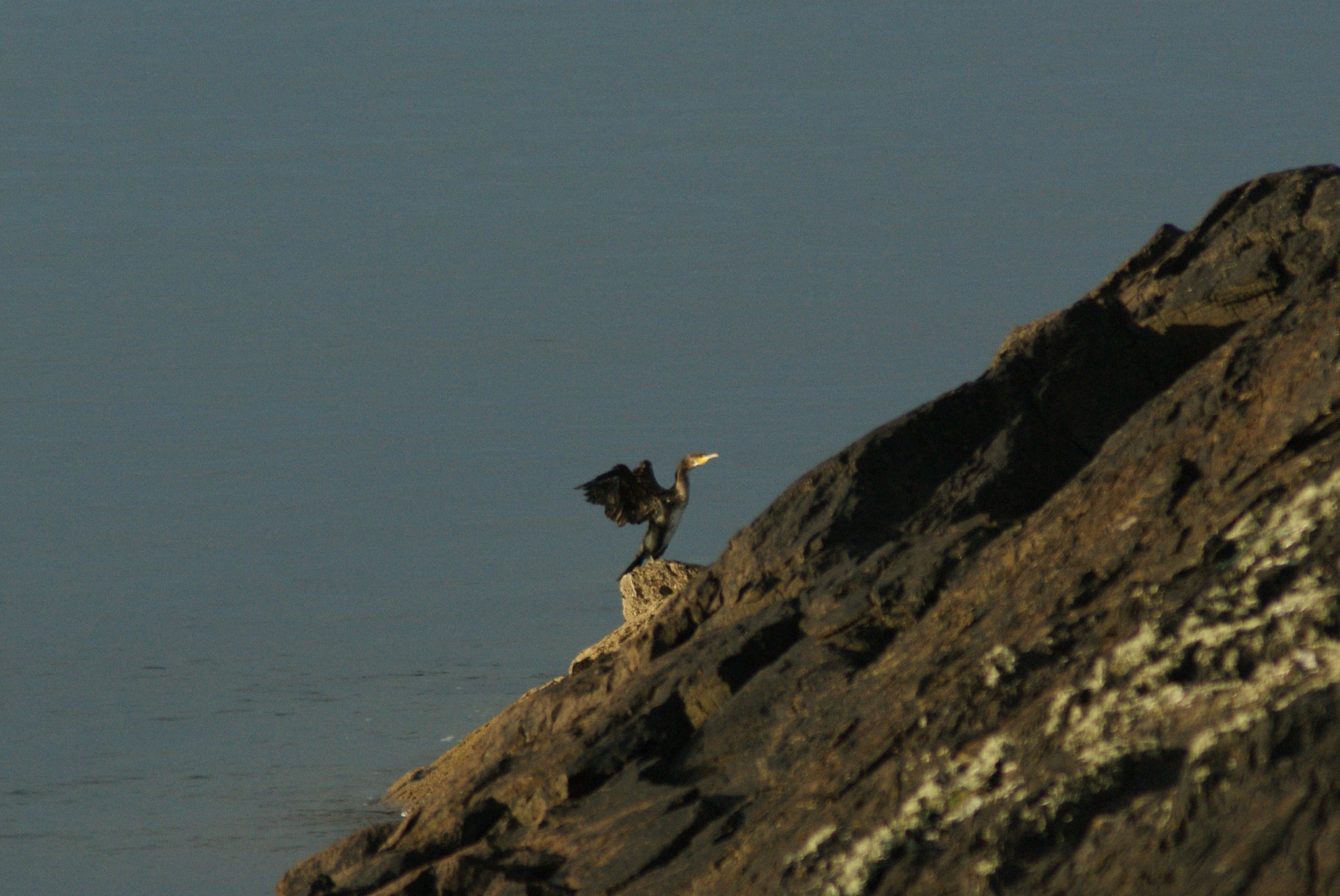
18. Glanbeg Beach
This stop doesn’t include any walking. On the side of the road between Caherdaniel and Sneem, it is easy to stop and take in the scenery. Regardless of the time of year, you might see Cormorants (Broigheall), Shags (Seaga) and the Eurasian Oystercatcher (Roilleach). The first two species can be hard to distinguish from each other. But no other bird has such a unique call as the oystercatcher, in addition to the striking black and white plumage with long, bright orange beak.
-
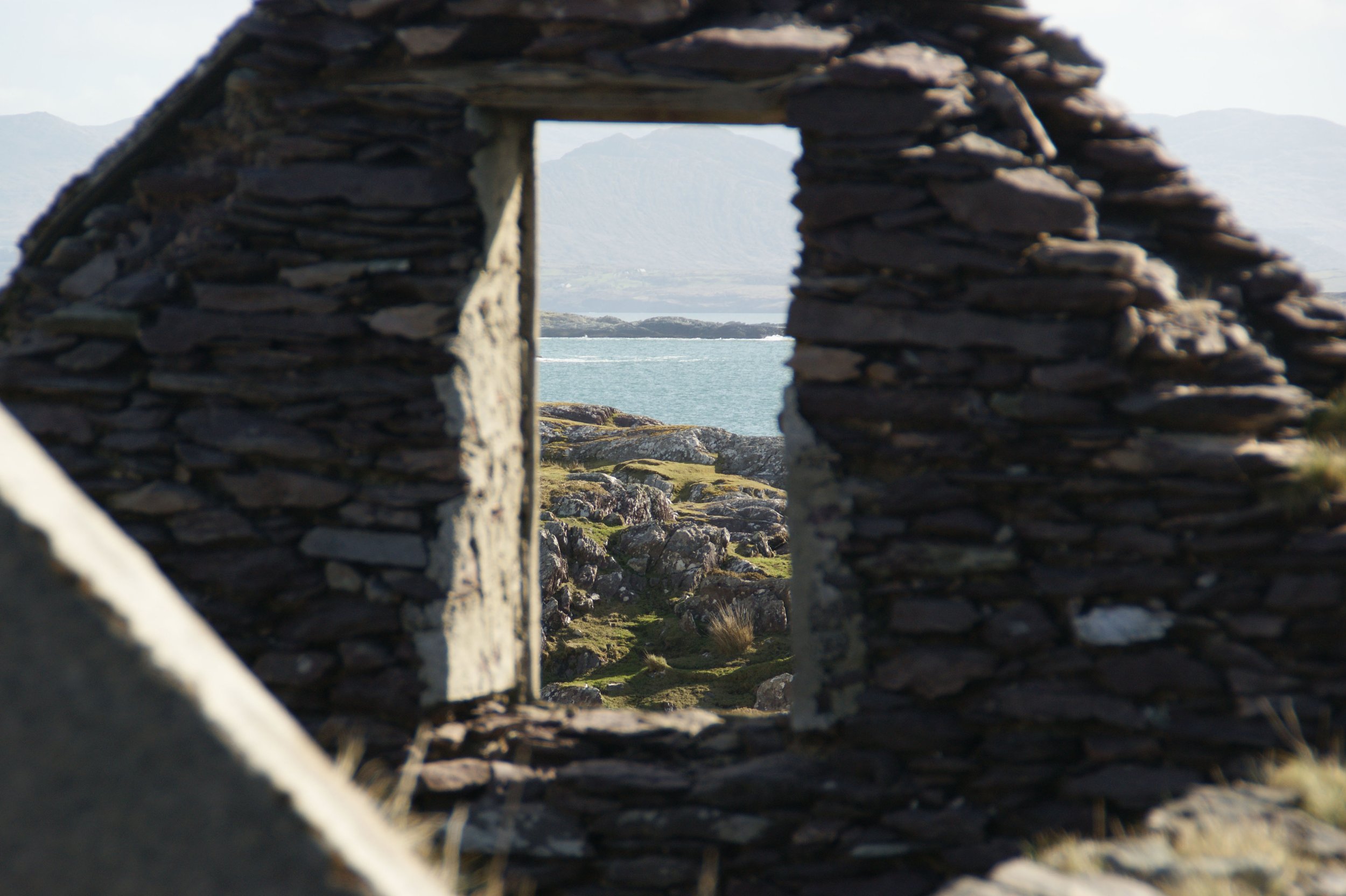
19. Gleesk Pier
A short drive on a narrow road off the N70 Ringroad will bring you to Gleesk Pier. Only a short walk towards the water, maybe even passing one of Ireland’s two maerl beaches, you will get another fantastic view of Kenmare Bay. Northern Gannets fish here all year round. Common Guillemots (Muiréan), Black Guillemots (Foracha dhubh) and Razorbills (Crosán) can be seen sitting on the water during spring, summer and autumn too, as many breed close by.
-

20. Tahilla Pier
Cormorants (Broigheall) and Shags (Seaga) are easy to spot resting on buoys of crab fishing gear and along exposed rocks. A good time to come here is during low tide, because that is when you will have your best chances to see Seals (Rón) hauled out to your left. Other birds that you might observe along the shore all year round are Grey Heron (Corr éisc) and Eurasian Oystercatcher (Roilleach), whereas Black Guillemots (Foracha dhubh) and Sandwich Terns (Geabhróg scothdhubh) are commonly seen (and heard) summer visitors.
If you enjoy hiking and would like to see more of the areas surrounding the watch locations, a good place to look for more is on our website as well as the South Kerry Trails of the South Kerry Development Partnership CLG. If you are looking for some inspiration through the seasons, here is where to find it.
If you are interested in seeing more of Kenmare Bay and its fascinating wildlife and landscapes from the boat, visit Skellig Coast Discovery and Skellig Tours. The latter is one of 15 licensed boat operators to land on Skellig Michael over the summer months, if the weather permits it. The other boats mainly leave from Portmagee. On days where Skellig landings are not possible, wildlife tours may be offered by most operators, with Kerry Aquaterra from Portmagee and Skellig Falcon from Glen Pier exclusively offering coastal and bay tours (no Skellig landings).



